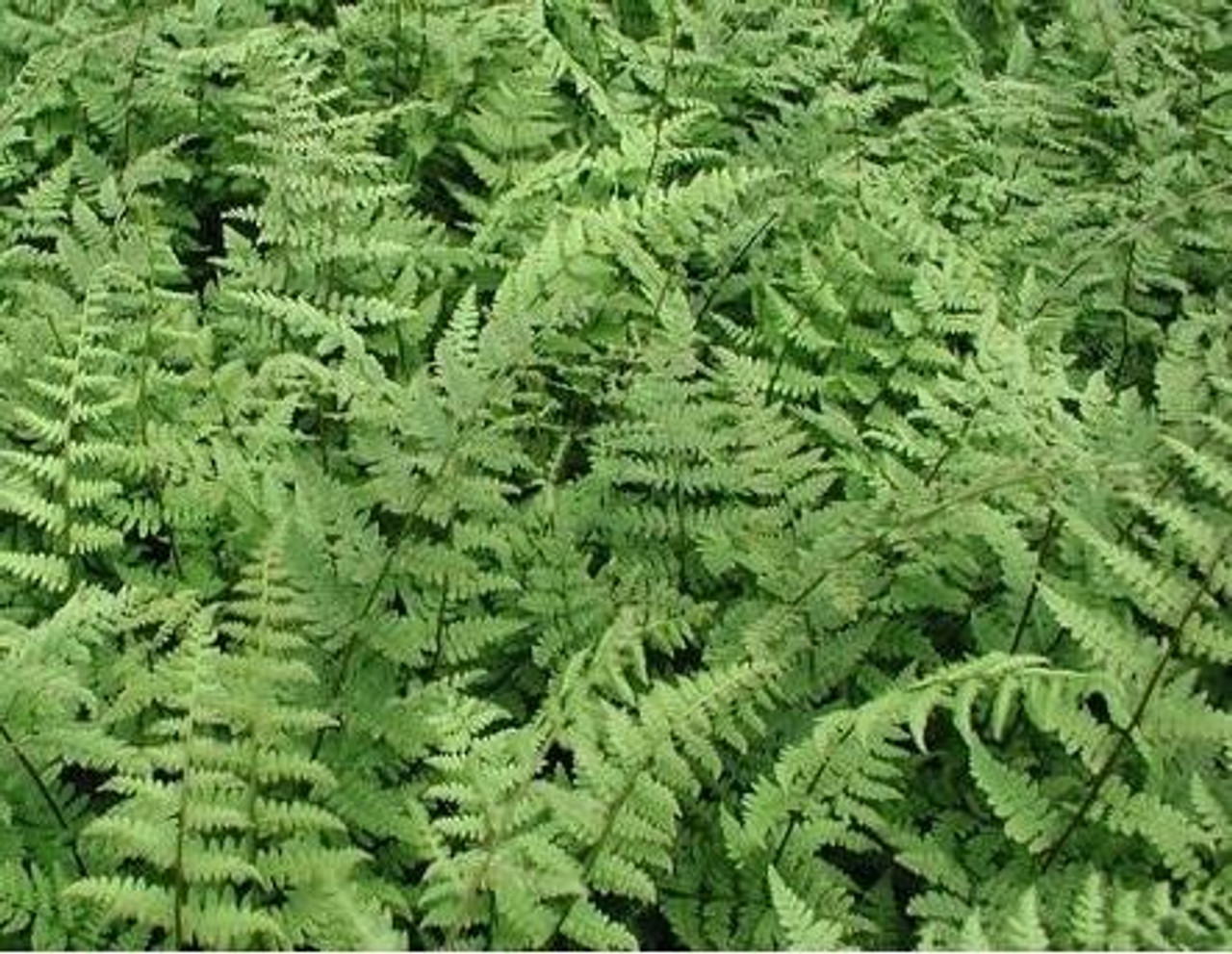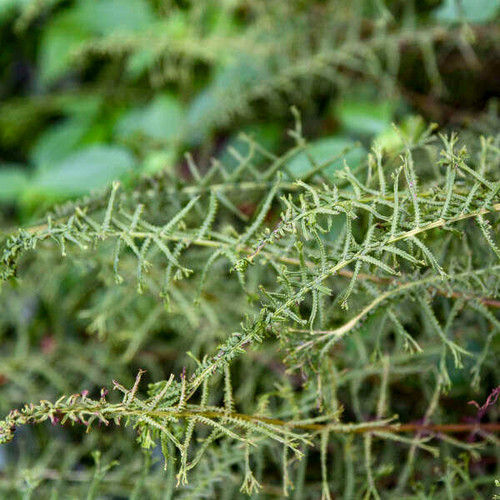Product Description
Athyrium filix-femina (3.5-inch pot)
Common name: Lady Fern
- Height: 24-36 Inches
- Spread: 24-36 Inches
- Hardiness Zone: 3-8
- Part Shade to Shade
- Deciduous
- Native
- Slow spreading by rhizomes
- Fine textured,light green,lacy-like fronds
- Tolerates sun with constant moisture
- Tolerates dry soil better than most
Athyrium filix-femina - Lady Fern- Deciduous. Bright green, erect fronds are fine textured and lacy-like, twice pinnate and can reach 3' long and 1' wide. Lady Fern spreads slowly by rhizomes forming clumps that expand slowly. Thrives in rich, moist soil. Bright fern for the shade garden, woodland areas, stream and pond banks. Tolerates dry soil relatively well. Sun exposure requires consistent moisture. Mature height 24"-36", spread 24"-36".
Native to North America, this deciduous is common to moist sites throughout the northern hemisphere. It is characterized by lush, finely textured, medium green fronds with an arching habit. They radiate gracefully out from the center of the crown. New leaves are produced throughout the season for a continually fresh look. At maturity, the stems turn dark red.
Athyrium grows best in moist soil with a neutral to moderately acidic pH. Partial to full shade is best. To protect the crowns and tender shoots in the spring, it is best to leave the old fronds on the plant over the winter. They can be removed in the spring when the new fronds reach 6 inches tall. If division is necessary, do so in the spring.
This is useful as a background plant in shade gardens and is also beautiful planted en masse along streams or woodland settings. It is a vigorous grower, especially in loamy humus-rich soils, but spreads relatively slowly and doesn't run. It is also reported to be more tolerant of sun and dry soils than many other ferns.
Royal Horticultural Society's Award of Garden Merit 1993
Athyrium filix-femina, commonly known as the Lady Fern, is a graceful and delicate fern that adds a touch of woodland charm to gardens. Here is a closer look at this beautiful plant:
Appearance:
- Fronds: The Lady Fern features lacy, light green fronds that grow in a graceful, arching habit. The fronds are finely divided, giving them a delicate and feathery texture. They typically grow 2-3 feet tall, creating a lush and airy presence.
Growth Habit:
- The Lady Fern forms a clump of fronds that grow from a central crown. It spreads slowly by rhizomes, gradually forming a colony.
Growing Conditions:
- Sunlight: This fern thrives in partial to full shade. It prefers a location with dappled sunlight or shade for most of the day.
- Soil: The Lady Fern prefers moist, well-drained soil that is rich in organic matter. It can tolerate some dryness once established, but it is best to keep the soil consistently moist, especially during its first year.
- Hardiness: It is generally hardy in USDA Zones 4-8, making it suitable for a wide range of climates.
Special Features:
- Delicate Texture: The finely divided fronds of the Lady Fern create a beautiful, lacy texture that adds visual interest to the shade garden.
- Adaptable: This fern is relatively adaptable and can tolerate a wider range of soil conditions than some other ferns.
- Low Maintenance: Once established, the Lady Fern is a relatively low-maintenance plant, requiring minimal care.
- Deer Resistant: Ferns are generally not a favorite of deer, making the Lady Fern a good choice for gardens where deer are a problem.
Uses in the Garden:
- Woodland Gardens: The Lady Fern is a natural choice for woodland gardens, where it can thrive in the dappled shade and moist soil.
- Shade Gardens: It can be used to add texture and interest to any shaded garden, whether it is a formal border or a naturalistic setting.
- Water Gardens: The Lady Fern can also be grown near ponds or streams, where it can tolerate the moist soil conditions.
- Containers: Its relatively compact size makes it suitable for container gardening, allowing you to enjoy its beauty on patios or balconies.
Tips for Growing Athyrium filix-femina:
- Planting: Plant in spring or fall in a shaded location with moist, well-drained soil. Amend the soil with compost or other organic matter to improve its fertility and drainage.
- Watering: Keep the soil consistently moist, especially during the first year. Once established, it can tolerate some dryness, but it is best to water it regularly during dry spells.
- Fertilizing: Apply a balanced fertilizer in spring as new growth begins.
- Mulching: Apply a layer of mulch around the plants to retain moisture, suppress weeds, and protect the roots from temperature fluctuations.
- Dividing: Divide clumps every few years in spring or fall to rejuvenate plants and maintain their vigor.
Overall, Athyrium filix-femina, the Lady Fern, is a beautiful and easy-to-grow fern that will add a touch of grace and elegance to your shade garden. Its delicate texture, adaptability, and low maintenance requirements make it a valuable addition to any landscape.
Other Details
The most important part of the plant is its root system. Healthy roots are the foundation of a healthy, vibrant plant. The type of plug container used is based on the specific needs of the plants. Perennials offered as bare root traditionally perform better when planted as bare root.Planted in a specialized mix, potted plants have well established root systems. Top growth stage will vary depending on the current life cycle and time of year when shipped. In Winter and early Spring dormant plants may be shipped. Dormant plants may be planted right away, even before the last frost date.
Most bare root varieties are field grown for at least one season, though Hemerocallis and Hosta are grown for two seasons. The bulk of the soil is removed during the harvesting process and the tops of most varieties are trimmed back to the crown. They are graded, packed in shredded aspen or sphagnum moss and stored in freezers until ready to be shipped.
See our Container Sizes and Bare Root Perennials pages for more information.
Plant information and care is provided in the Overview section, Plant Genus Page and general information is provided in the Planting Care & Guides. Additional questions can be asked on each Plant page.
Plant Spacing: Using the maximum mature spread or width of a plant to guide spacing, ensures space to grow to full size. To fill an area sooner, plant them closer together. Just remember, future thinning or transplanting may be needed.
Water: Keep a close eye on newly planted perennials, especially throughout the first growing year. Most early plant loss is due to too much or too little water!















